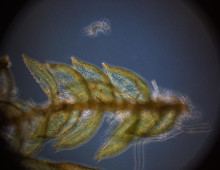Microbial Carbon Cycling in the Samail Ophiolite
Seeking a better understanding of adaptations necessary for life in active serpentinization sites, and to determine the role of viruses in diversification and liberation of organic carbon. [Read More]
 Seeking a better understanding of adaptations necessary for life in active serpentinization sites, and to determine the role of viruses in diversification and liberation of organic carbon. [Read More]
Seeking a better understanding of adaptations necessary for life in active serpentinization sites, and to determine the role of viruses in diversification and liberation of organic carbon. [Read More] How Cyanidiophyceae, a group of unicellular red algae that occupies a variety of hot springs and acid mining sites, become extremophiles. [Read More]
How Cyanidiophyceae, a group of unicellular red algae that occupies a variety of hot springs and acid mining sites, become extremophiles. [Read More] This project focuses on the genomes of thirty-two saprobic Agaricales, for a large repertoire of enzymes acting on plant biomass. [Read More]
This project focuses on the genomes of thirty-two saprobic Agaricales, for a large repertoire of enzymes acting on plant biomass. [Read More] Investigating the ways in which intersecting biological, chemical, and physical processes shape the terrestrial subsurface, with feedbacks to the regional or global system. [Read More]
Investigating the ways in which intersecting biological, chemical, and physical processes shape the terrestrial subsurface, with feedbacks to the regional or global system. [Read More] This project focuses on the diversity of isolates of the white rot basidiomycete Dichomitus squalens. [Read More]
This project focuses on the diversity of isolates of the white rot basidiomycete Dichomitus squalens. [Read More] As a global carbon sink, the health and productivity of this ecosystem is important to preventing future increases in carbon dioxide emissions. [Read More]
As a global carbon sink, the health and productivity of this ecosystem is important to preventing future increases in carbon dioxide emissions. [Read More] Over 800 million hectares of land throughout the world are salt-affected and a common method for dealing with salt stress problems is to reclaim affected soils with fast-growing salt- tolerant tree species such as Casuarina trees. Fast growing trees from the Casuarinaceae family have been successfully introduced in several tropical and subtropical countries to prevent… [Read More]
Over 800 million hectares of land throughout the world are salt-affected and a common method for dealing with salt stress problems is to reclaim affected soils with fast-growing salt- tolerant tree species such as Casuarina trees. Fast growing trees from the Casuarinaceae family have been successfully introduced in several tropical and subtropical countries to prevent… [Read More] The Antarctic Dry Valley system represents one of the harshest and most extreme environments inhabited by microorganisms on Earth. The soils of these valleys contain microbes that must cope with cold temperatures, poor water and nutrient availability, high salinities, exposure to high doses of ultraviolet radiation, and lack of sunlight during polar winters. Such an… [Read More]
The Antarctic Dry Valley system represents one of the harshest and most extreme environments inhabited by microorganisms on Earth. The soils of these valleys contain microbes that must cope with cold temperatures, poor water and nutrient availability, high salinities, exposure to high doses of ultraviolet radiation, and lack of sunlight during polar winters. Such an… [Read More] Setaria viridis is the wild progenitor of S. italica, more commonly known as foxtail millet. Green foxtail is related to other grasses that have been considered candidate bioenergy feedstocks such switchgrass, Miscanthus and sorghum. Both green foxtail and foxtail millet have been sequenced by the DOE JGI, and this project focuses on understanding and promoting… [Read More]
Setaria viridis is the wild progenitor of S. italica, more commonly known as foxtail millet. Green foxtail is related to other grasses that have been considered candidate bioenergy feedstocks such switchgrass, Miscanthus and sorghum. Both green foxtail and foxtail millet have been sequenced by the DOE JGI, and this project focuses on understanding and promoting… [Read More] Lobaria pulmonaria is a lichen found in the northern hemisphere that contributes locally to carbon cycling at an ecosystem level. Lichens themselves are microecosystems composed of fungi, unicellular green algae and cyanobacteria while also hosting other organisms. These associations involve coordinating and reshaping the growth of very different species – from two – sometimes three… [Read More]
Lobaria pulmonaria is a lichen found in the northern hemisphere that contributes locally to carbon cycling at an ecosystem level. Lichens themselves are microecosystems composed of fungi, unicellular green algae and cyanobacteria while also hosting other organisms. These associations involve coordinating and reshaping the growth of very different species – from two – sometimes three… [Read More]